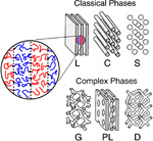Home > Press > Heterogeneous nanoblocks give polymers an edge: Study uncovers the effects of size variation in nanoscale blocks used in polymer mixes
 |
Abstract:
Building structures by mixing lego bricks of two different sizes is child's play. However, studying polymers endowed with an alternating nanostructure made of heterogeneous blocks is anything but straightforward. Theoretical physicist Mark Matsen, based at the University of Reading, UK, studies polymer mixes consisting of two-fold (AB) and three-fold (BAB) combinations of two types of nanoscale blocks. He has shown, in a study published in EPJ E, that the underlying heterogeneity of the blocks can cause polymers to switch to different nanoscale patterns and therefore display different properties. Numerous applications based on etching patterns on substrates, such as electronics, computer chips, and membranes endowed with a specific function, can benefit from such research.
Heterogeneous nanoblocks give polymers an edge: Study uncovers the effects of size variation in nanoscale blocks used in polymer mixes
Heidelberg, Germany | Posted on August 5th, 2013The problem is that, for a long time, polymer experts thought that achieving such an ordered nanostructure required using nanoblocks of similar sizes. However, experimentalists have recently shown that is not necessarily the case. As it turns out, it is generally sufficient to synthesise block copolymers using less costly methods, which result in block components of heterogeneous sizes.
To understand the effect of heterogeneous blocks on such polymer melts, the author compares polymer architectures made of three blocks, namely BAB, and two blocks, namely AB. In this case, A blocks are of heterogeneous size and B blocks are of homogeneous size. He relies on a method called self-consistent field theory (SCFT), which involves approximating the effect of all the other polymers on any given polymer by an averaged effect.
Matsen found that the use of heterogeneous building blocks affects the morphological structure of polymers at the nanometric scale. He also realised that by using heterogeneous components, particularly with triblocks, it is possible to shift the width of sub-domains made of one type of polymer. This could, for example, help in improving the effectiveness of triblock-based refractive surfaces.
####
For more information, please click here
Contacts:
Sophia Grein
49-622-148-78414
Copyright © Springer
If you have a comment, please Contact us.Issuers of news releases, not 7th Wave, Inc. or Nanotechnology Now, are solely responsible for the accuracy of the content.
| Related Links |
| Related News Press |
News and information
![]() Researchers develop molecular qubits that communicate at telecom frequencies October 3rd, 2025
Researchers develop molecular qubits that communicate at telecom frequencies October 3rd, 2025
![]() Next-generation quantum communication October 3rd, 2025
Next-generation quantum communication October 3rd, 2025
![]() "Nanoreactor" cage uses visible light for catalytic and ultra-selective cross-cycloadditions October 3rd, 2025
"Nanoreactor" cage uses visible light for catalytic and ultra-selective cross-cycloadditions October 3rd, 2025
Chip Technology
![]() Lab to industry: InSe wafer-scale breakthrough for future electronics August 8th, 2025
Lab to industry: InSe wafer-scale breakthrough for future electronics August 8th, 2025
![]() A 1960s idea inspires NBI researchers to study hitherto inaccessible quantum states June 6th, 2025
A 1960s idea inspires NBI researchers to study hitherto inaccessible quantum states June 6th, 2025
![]() Programmable electron-induced color router array May 14th, 2025
Programmable electron-induced color router array May 14th, 2025
Discoveries
![]() Researchers develop molecular qubits that communicate at telecom frequencies October 3rd, 2025
Researchers develop molecular qubits that communicate at telecom frequencies October 3rd, 2025
![]() Next-generation quantum communication October 3rd, 2025
Next-generation quantum communication October 3rd, 2025
![]() "Nanoreactor" cage uses visible light for catalytic and ultra-selective cross-cycloadditions October 3rd, 2025
"Nanoreactor" cage uses visible light for catalytic and ultra-selective cross-cycloadditions October 3rd, 2025
Materials/Metamaterials/Magnetoresistance
![]() First real-time observation of two-dimensional melting process: Researchers at Mainz University unveil new insights into magnetic vortex structures August 8th, 2025
First real-time observation of two-dimensional melting process: Researchers at Mainz University unveil new insights into magnetic vortex structures August 8th, 2025
![]() Researchers unveil a groundbreaking clay-based solution to capture carbon dioxide and combat climate change June 6th, 2025
Researchers unveil a groundbreaking clay-based solution to capture carbon dioxide and combat climate change June 6th, 2025
![]() A 1960s idea inspires NBI researchers to study hitherto inaccessible quantum states June 6th, 2025
A 1960s idea inspires NBI researchers to study hitherto inaccessible quantum states June 6th, 2025
![]() Institute for Nanoscience hosts annual proposal planning meeting May 16th, 2025
Institute for Nanoscience hosts annual proposal planning meeting May 16th, 2025
Announcements
![]() Rice membrane extracts lithium from brines with greater speed, less waste October 3rd, 2025
Rice membrane extracts lithium from brines with greater speed, less waste October 3rd, 2025
![]() Researchers develop molecular qubits that communicate at telecom frequencies October 3rd, 2025
Researchers develop molecular qubits that communicate at telecom frequencies October 3rd, 2025
![]() Next-generation quantum communication October 3rd, 2025
Next-generation quantum communication October 3rd, 2025
![]() "Nanoreactor" cage uses visible light for catalytic and ultra-selective cross-cycloadditions October 3rd, 2025
"Nanoreactor" cage uses visible light for catalytic and ultra-selective cross-cycloadditions October 3rd, 2025
Interviews/Book Reviews/Essays/Reports/Podcasts/Journals/White papers/Posters
![]() Spinel-type sulfide semiconductors to operate the next-generation LEDs and solar cells For solar-cell absorbers and green-LED source October 3rd, 2025
Spinel-type sulfide semiconductors to operate the next-generation LEDs and solar cells For solar-cell absorbers and green-LED source October 3rd, 2025
![]() Rice membrane extracts lithium from brines with greater speed, less waste October 3rd, 2025
Rice membrane extracts lithium from brines with greater speed, less waste October 3rd, 2025
|
|
||
|
|
||
| The latest news from around the world, FREE | ||
|
|
||
|
|
||
| Premium Products | ||
|
|
||
|
Only the news you want to read!
Learn More |
||
|
|
||
|
Full-service, expert consulting
Learn More |
||
|
|
||








